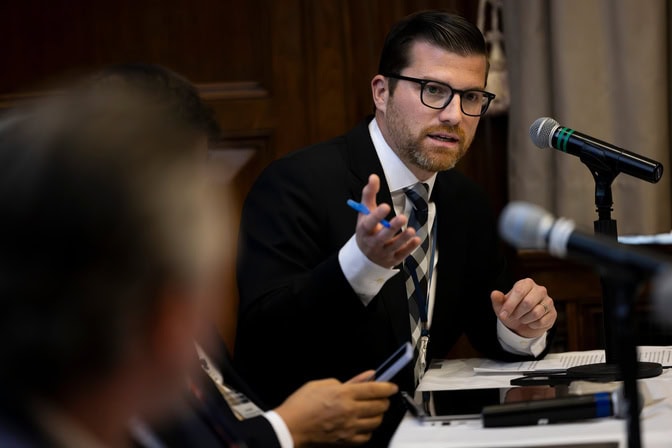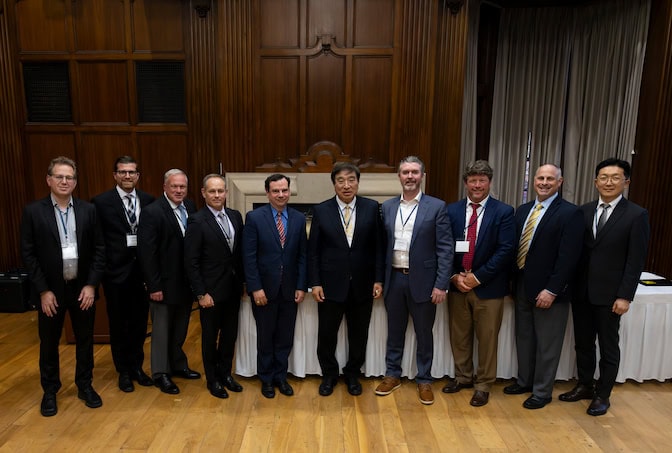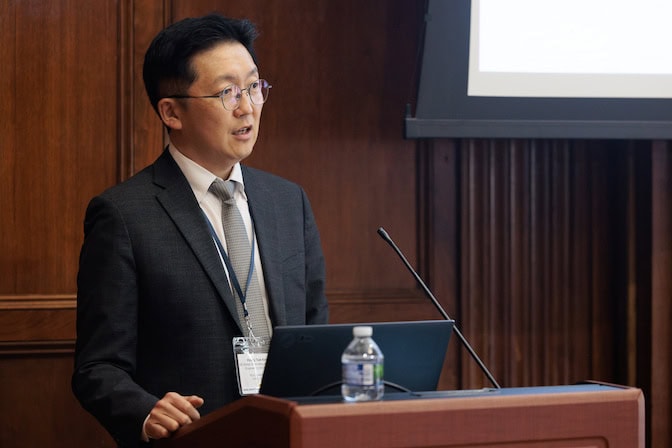
Shipbuilders and maritime policy experts discuss US industry at U-M
To be globally competitive, the U.S. needs to make ships for the future, panelists say.

To be globally competitive, the U.S. needs to make ships for the future, panelists say.
Experts
Global leaders in shipbuilding and naval architecture from the United States and South Korea met at the University of Michigan recently to discuss how to improve the capabilities of each nation’s fleet and shipbuilding capacity.
Executives from South Korea’s leading shipbuilding company, HD Hyundai, and Lincoln Electric, an international welding and automation company headquartered in Cleveland, shared their recent advances in welding and vessel automation, and policy experts led a panel discussion on how to collaborate to restore U.S. shipbuilding capacity to globally competitive levels. To bring these industry leaders together, the University of Michigan funded the expert panel via the Boost program.

“There’s a lot of activity across the board in this space,” said David Singer, a U-M professor of naval architecture and marine engineering who organized and ran the forum. “I’m hoping to bring everyone together so we can collaborate and bring our combined efforts to scale.”
The event was part of U-M’s ongoing effort to build international coalitions that can improve U.S. shipbuilding and America’s maritime workforce, including student exchange programs with HD Hyundai, one of the world’s largest shipbuilding companies, and Seoul National University, South Korea’s top-ranked university.
“New strengths in shipbuilding depend on how people and technology grow together,” said Kwang Pil Chang, the senior executive vice president and head of the Future Technology Research Institute at HD Hyundai, in a recorded video address. “This forum gives us a great chance to turn our shared vision into meaningful action.”
The U.S. dominated global shipbuilding in the 1910s and 1940s, but today, the country builds almost no ocean-going, commercial ships. Some experts and policy makers worry the gap threatens American economic and national security.
American shipbuilding diminished in part because its ships weren’t technologically competitive, said William Cahill, who served as director for strategic planning on the National Security Council and as maritime adviser on the Council of Economic Advisers in the first Trump Administration, in a presentation ahead of the panel.
Cahill explained that the U.S. led the world in building wooden sailing ships during the 19th century, but they were later surpassed by Britain in modern steel shipbuilding. The U.S. led global shipbuilding again during World War II, but then failed to pivot to a commercially oriented customer after the war. Meanwhile, Japan, South Korea and China focused on competing in commercial markets, building the large ships that facilitate international trade.

“We have one supplier, and we are the only customer,” said panelist Steven Brock, who was senior advisor to former Secretary of the Navy Carlos Del Toro. “When you are in a monopoly- monopsy relationship, you don’t benefit from the necessary capital investment, innovation and efficiencies that a competitive marketplace delivers in terms of affordability, timeliness and quality.
Other panelists said that a viable U.S. shipbuilding industry will have to build ships that customers around the world want to buy. And a valuable ship will meet the challenges and demands of the future.
“We need to be thinking about what the next step looks like for shipyards or marine transportation systems overall,” said panelist David Walker, vice president of global government for the American Bureau of Shipping. “Autonomy, robotics, drone-operations and advanced nuclear are really step-change opportunities where the U.S. can be competitive and differentiated.”

Partnerships with HD Hyundai and Seoul National University can help American engineers tap into leading expertise in automated ships and shipbuilding technology. At the forum, Jong Hun Woo, a professor of naval architecture and ocean engineering, presented his lab’s advancements in AI-powered shipyard automation. Hyung Taek Kim, senior vice president at HD Hyundai presented the “world’s first transoceanic voyage with autonomous navigation” alongside other automated safety systems.

U-M is also building teams to develop technology and strategy to equip commercial ships with advanced nuclear reactors, which provide carbon-free power and enable ships to go years without refueling. Thomas McKenney, a U-M associate professor of practice of naval architecture and marine engineering, is forming collaborative projects with Won Sik Yang and Xiaodong Sun, U-M professors of nuclear engineering and radiological science. McKenney has also partnered with Matthew Collette, a U-M professor of naval architecture and marine engineering, to organize a maritime nuclear energy forum with the Michigan Economic Development Center and Newlab Detroit, a venture platform that unites entrepreneurs and engineers to test, pilot and scale critical technologies.
“The thing that’s missing is for someone from outside the maritime industry to shock the system and do things outside of conventional thinking,” said panelist Brent Sadler, a senior research fellow of naval warfare and advanced technology at the Heritage Foundation.